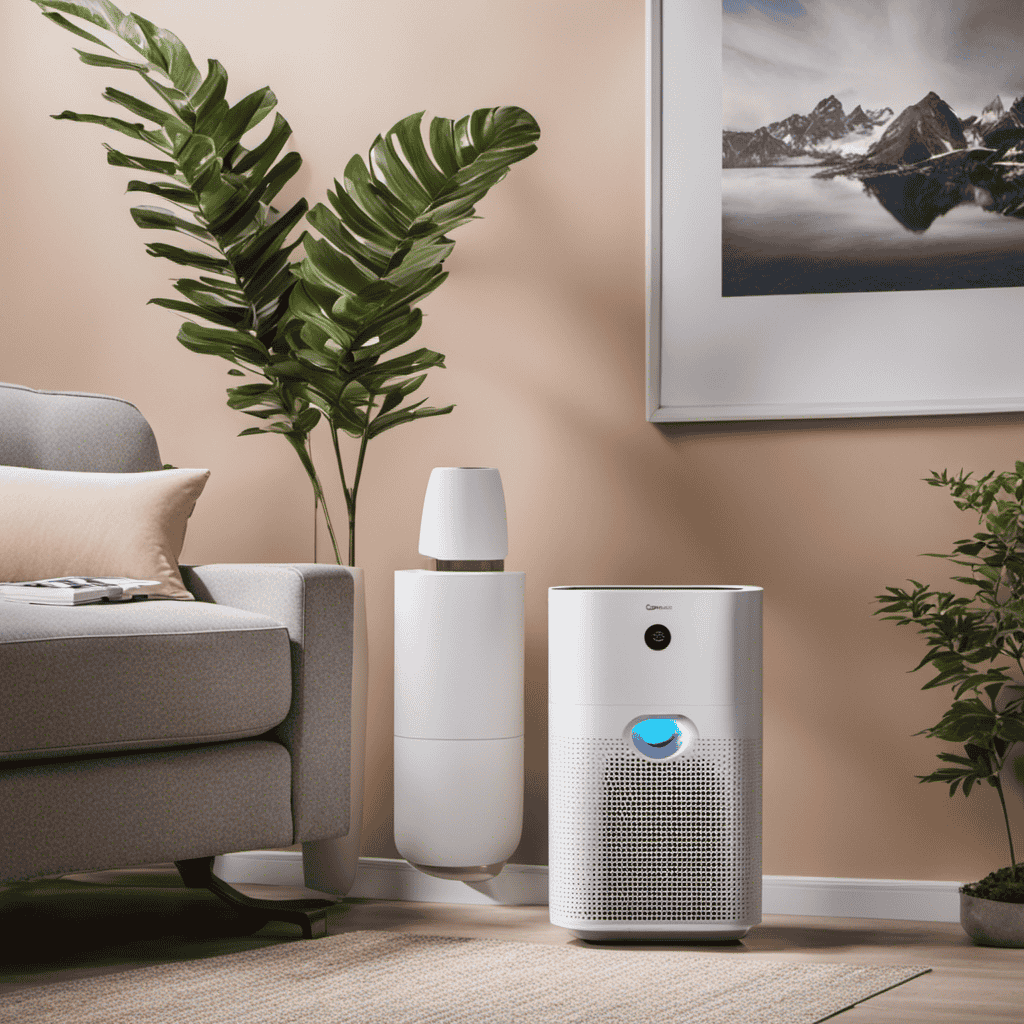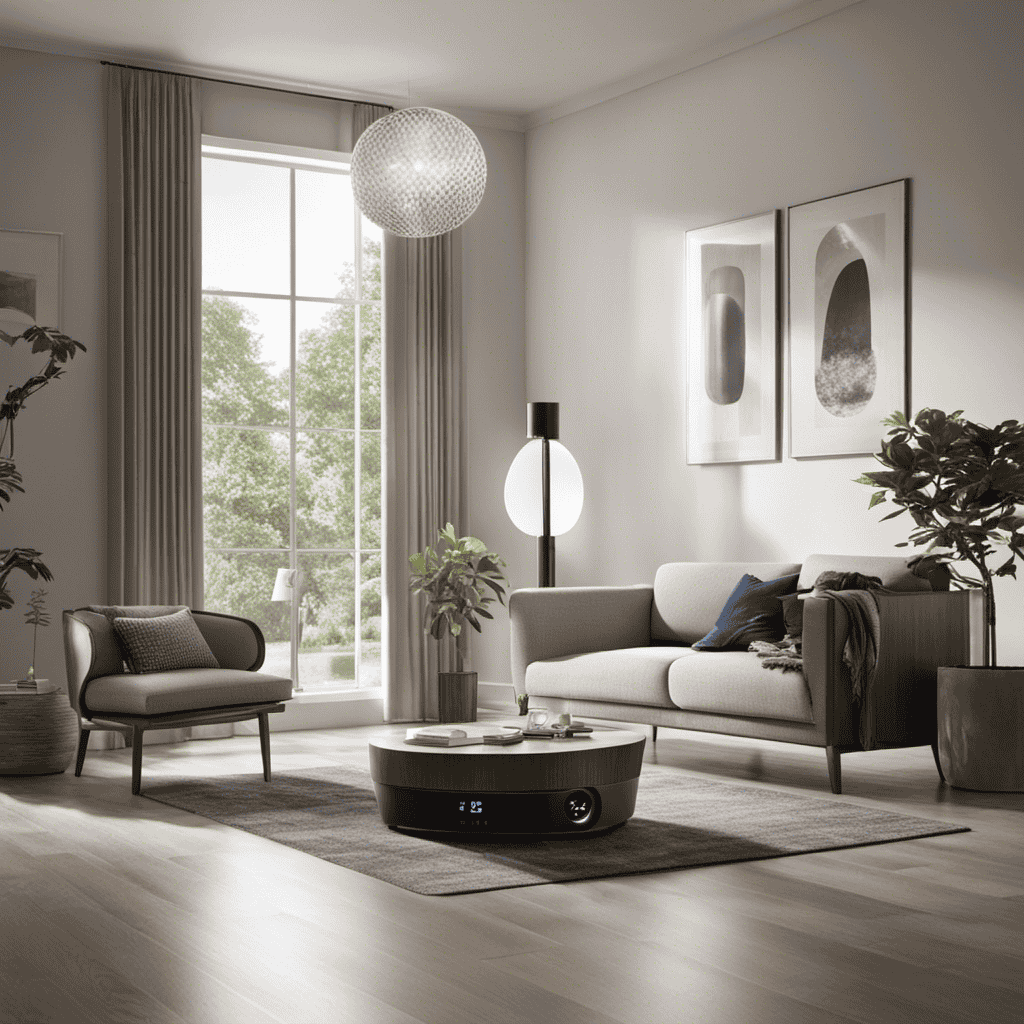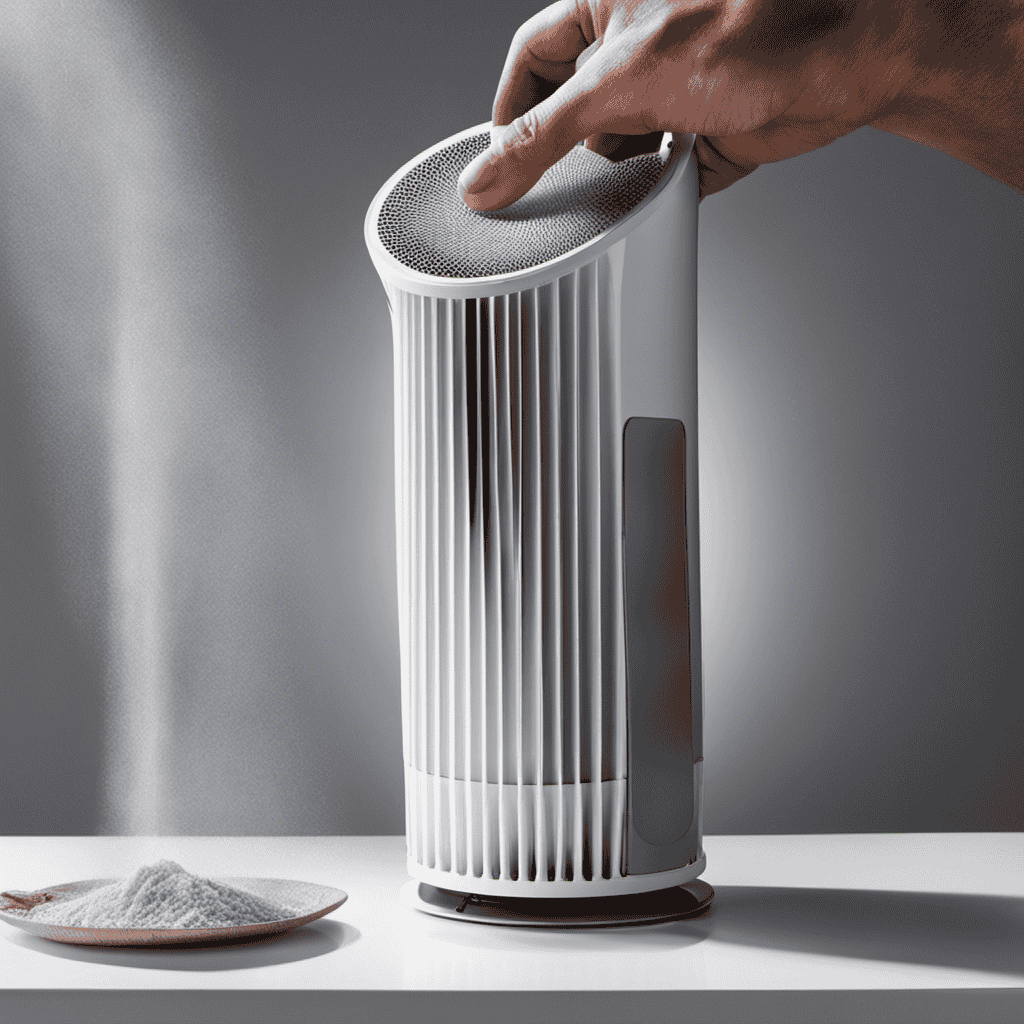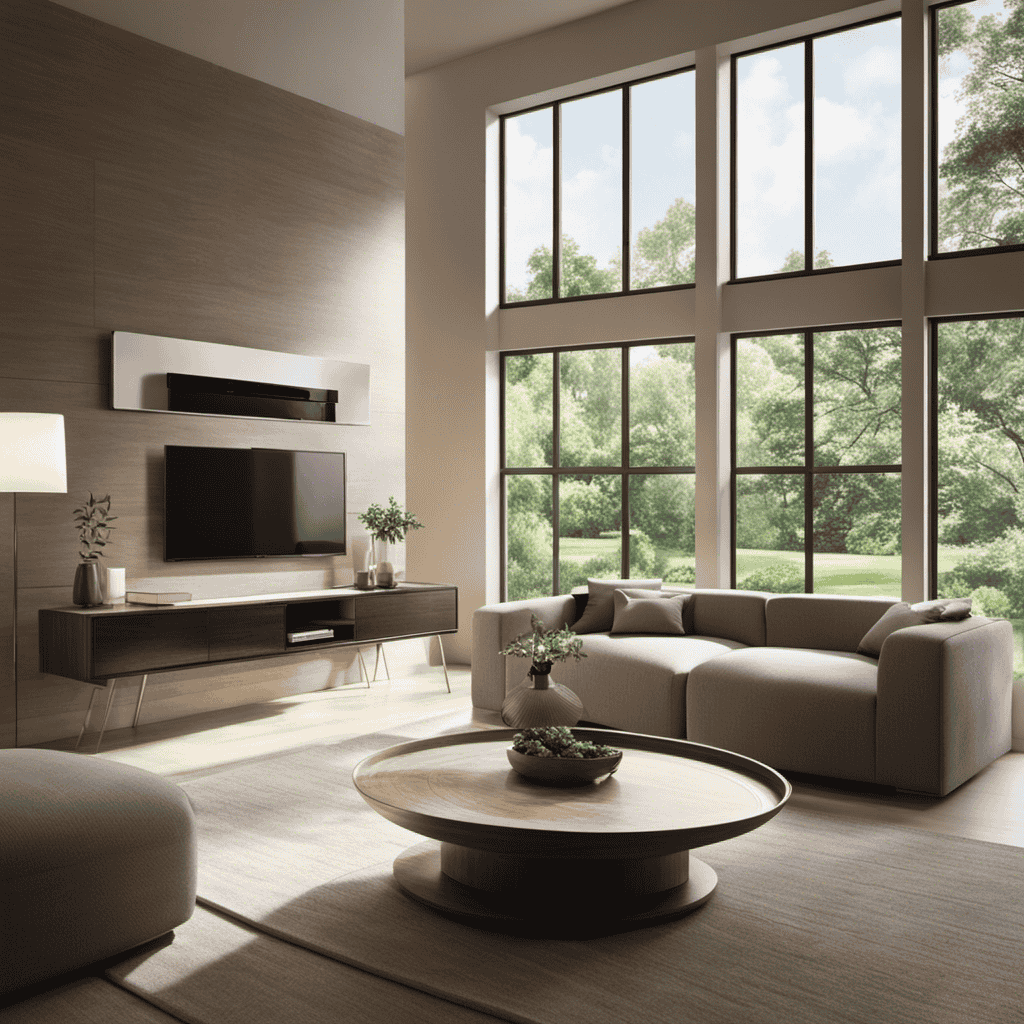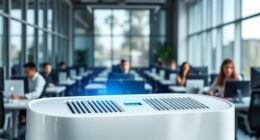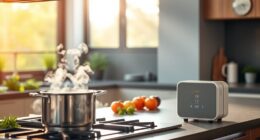I have always been curious about the frequency at which I should replace the filter in my air purifier. This is a crucial concern as a clean filter is essential for ensuring that the air purifier effectively eliminates pollutants and allergens from the air.
In this article, we will delve into the factors that determine filter lifespan, signs that indicate it’s time for a replacement, and the recommended frequency for filter changes. By understanding these key points, you’ll be able to extend the lifespan of your air purifier filter and keep your indoor air quality at its best.
Key Takeaways
- Regular filter replacement is necessary to maintain optimal efficiency and effectiveness of an air purifier.
- Different filter types have different lifespans, and factors such as air pollution levels, pet ownership, and smoking can affect the lifespan of a filter.
- Reduced airflow and decreased purifier effectiveness are signs that indicate it’s time to change the filter.
- Neglecting filter replacement can lead to health issues, as pollutants can circulate and accumulate without proper filtration.
Understanding the Importance of Filter Replacement
It’s crucial to understand the importance of regularly changing the filter in an air purifier. Filter maintenance plays a significant role in ensuring the efficiency of an air purifier.
Over time, the filter accumulates dust, allergens, and other particles from the air. As these particles build up, the filter becomes less effective at capturing and removing them from the indoor environment. This leads to decreased filter efficiency and reduced air purification performance.
Regularly replacing the filter is necessary to maintain optimal filter efficiency. It is recommended to follow the manufacturer’s guidelines for filter replacement, which typically range from every three to six months, depending on the air quality and usage.
Factors That Determine Filter Lifespan
One factor that determines how frequently a filter should be replaced in an air purifier is the overall air quality in your home.
The following factors also play a role in determining filter lifespan:
- Filter maintenance: Regularly cleaning and maintaining the filter can extend its life and improve filter efficiency.
- Filter type: Different types of filters have different lifespans. HEPA filters, for example, typically last longer than activated carbon filters.
- Air pollution levels: If your home is in an area with high levels of air pollution, the filter may need to be replaced more frequently.
- Pet ownership: Pets can introduce additional dander and hair into the air, which can clog the filter more quickly.
- Smoking: If you or someone in your home smokes, it can decrease the lifespan of the filter due to the increased presence of smoke particles.
Understanding these factors can help you determine when it’s time to change the filter in your air purifier.
Signs That Indicate It’s Time to Change the Filter
When it comes to maintaining optimal air quality in your home or office, understanding the frequency of filter replacement is crucial.
Regularly changing the filter ensures that it continues to effectively trap and remove pollutants from the air.
Performance degradation indicators, such as reduced airflow or a noticeable decrease in the purifier’s effectiveness, serve as clear signs that it’s time for a filter replacement.
Neglecting to change the filter on time can have serious health implications, as it allows pollutants to circulate and accumulate, potentially triggering respiratory issues or allergies.
Filter Replacement Frequency
The filter in an air purifier usually needs to be changed every three to six months. Regular filter maintenance is crucial for improving air quality and ensuring the optimal performance of the air purifier. Understanding filter maintenance can help maximize its efficiency and prolong its lifespan.
Here are some key points to consider:
-
Filter lifespan: Filters typically have a recommended lifespan of three to six months, but this can vary depending on factors such as the air quality and usage of the purifier.
-
Air quality monitoring: Regularly checking the air quality in your home can help determine when it’s time to change the filter. High levels of pollutants or allergens may require more frequent filter replacements.
-
Filter type: Different air purifiers use different types of filters, such as HEPA filters or activated carbon filters. Understanding the specific filter type and its recommended replacement frequency is essential.
-
Visual inspection: Regularly inspecting the filter for visible dirt, dust, or discoloration can indicate that it needs to be replaced.
-
Manufacturer’s recommendations: Always refer to the manufacturer’s instructions and recommendations for the specific air purifier model to ensure proper filter maintenance.
Performance Degradation Indicators
Regularly checking the filter for visible dirt, dust, or discoloration can indicate it’s time for a replacement. These performance indicators are crucial for effective filter maintenance.
As an air purifier user, it is important to understand that a dirty or clogged filter can significantly impact the efficiency of your purifier. When the filter becomes overloaded with particles, it can lead to reduced airflow and decreased filtration performance. This means that your air purifier may not be able to effectively remove pollutants from your indoor air, resulting in poor air quality.
Neglecting filter maintenance can have detrimental health implications, as it allows airborne contaminants to circulate freely in your living space. Therefore, it is essential to prioritize regular filter checks and replacements to ensure optimal performance and safeguard your health.
Health Implications of Neglect
Neglecting filter maintenance can lead to detrimental health implications, as it allows airborne contaminants to circulate freely in your living space. To ensure the health and well-being of yourself and your loved ones, it is essential to follow proper maintenance tips for your air purifier filters.
Here are some crucial points to keep in mind:
-
Regular filter replacement: Replace your air purifier filters according to the manufacturer’s recommendations. This helps ensure optimal efficiency and reduces the risk of contaminants being released back into the air.
-
Cleaning intervals: Clean reusable filters regularly to remove accumulated dirt and debris. This helps maintain their effectiveness and prolongs their lifespan.
-
Filter quality: Invest in high-quality filters that can effectively capture a wide range of airborne particles, including allergens, dust, mold spores, and pet dander.
-
Filter type selection: Choose the right type of filter for your specific needs, such as HEPA filters for allergies or activated carbon filters for odors and chemicals.
-
Monitor filter performance: Keep an eye on your air purifier’s filter replacement indicator or schedule regular checks to ensure your filters are functioning properly.
Recommended Frequency for Filter Replacement
When it comes to optimal filter replacement in air purifiers, several factors play a crucial role in determining the frequency at which you should change the filter. These factors include the air quality in your environment, the type of filter used, and the manufacturer’s recommendations.
Optimal Filter Replacement
It’s important to check the manufacturer’s guidelines for the optimal filter replacement schedule. Following the recommended maintenance schedule ensures that your air purifier continues to function effectively in removing airborne pollutants from your indoor environment.
Here are some filter maintenance techniques to consider:
- Regularly inspect the filter for dust and debris buildup.
- Clean the pre-filter, if applicable, to prolong the lifespan of the main filter.
- Replace the filters according to the manufacturer’s instructions, typically every 6 to 12 months.
- Consider changing the filters more frequently if you have pets or live in an area with high pollution levels.
- Keep track of the filter replacement schedule to ensure optimal air purification efficiency.
Factors Affecting Replacement Frequency?
Factors that can affect how frequently you replace your filters include the level of pollutants in your environment and whether or not you have pets. These factors can impact the efficiency of your air purifier filter and determine how often it needs to be replaced. Let’s take a closer look at the factors that can impact filter efficiency:
| Factors | Impact on Filter Efficiency |
|---|---|
| Pollutant level | Higher levels can clog filters faster |
| Pet presence | Pet dander and hair can reduce filter lifespan |
To prolong the lifespan of your air purifier filter, there are a few maintenance tips you can follow. Regularly cleaning and vacuuming your home can help reduce the amount of pollutants in the air. Additionally, keeping your pets groomed and minimizing their access to certain areas can also help. By taking these steps, you can extend the lifespan of your air purifier filter and ensure that it continues to effectively clean the air in your home.
Now, let’s delve into the next section on ‘extending the lifespan of your air purifier filter’.
Extending the Lifespan of Your Air Purifier Filter
To extend the lifespan of your air purifier filter, you should regularly clean it. Cleaning the filter helps remove accumulated dust, dirt, and other particles that can clog the filter and reduce its effectiveness.
Here are some maintenance tips to keep your air purifier filter working optimally:
- Vacuum or brush the filter regularly to remove surface dust.
- Rinse the filter with water to remove trapped particles.
- Allow the filter to dry completely before reinstalling it.
- Use a soft brush to gently remove stubborn debris.
- Consider using a filter cleaning solution for deep cleaning.
By following these maintenance tips, you can ensure that your air purifier filter lasts longer and continues to provide clean and fresh air in your home or office.
Choosing the Right Replacement Filter for Your Air Purifier
When choosing the right replacement filter for your air purifier, consider the specific model and size of your purifier. Different air purifiers have different filter sizes and types, so it’s important to find a replacement that fits properly and meets your needs. Additionally, you should also consider the filter efficiency and maintenance requirements. Higher filter efficiency means better air purification, but it may also require more frequent replacements. Regular maintenance is crucial to ensure optimal performance and longevity of your air purifier. To help you make an informed decision, here is a table summarizing the filter options for some popular air purifier models:
| Air Purifier Model | Filter Type | Filter Size |
|---|---|---|
| Model A | HEPA | 12x12x1 |
| Model B | Carbon | 14x14x2 |
| Model C | True HEPA | 10x20x1 |
| Model D | Pre-filter | 16x25x1 |
| Model E | UV-C | 20x25x4 |
Remember to consult your air purifier’s manual for specific recommendations and guidelines regarding filter replacements and maintenance.
Conclusion
In conclusion, maintaining a clean and efficient air purifier is vital for ensuring optimal indoor air quality. By regularly changing the filter, you can prevent harmful particles from circulating in your home.
Remember, the frequency of filter replacement depends on various factors such as usage, air quality, and the type of filter. So, don’t wait until it’s too late.
Imagine a breath of fresh air, free from allergens and pollutants, as you take control of your indoor environment by replacing your air purifier filter when needed.
